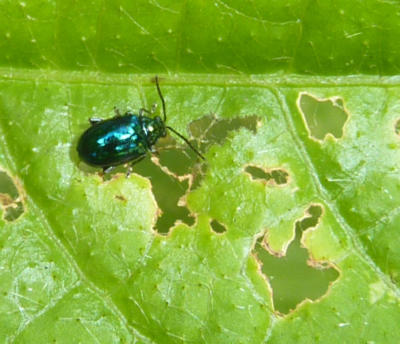Monomacra violacea ("Blue Flea Beetle")
The blue flea beetle may be found eating holes in the leaves of most Passiflora species, often in groups of 5-15. Host species include some highly cyanogenic species such as costaricensis and pittieri, indicating that M. violacea, like its congener M. chontalensis, may be able to tolerate cyanide-releasing chemicals in its diet. Its wide distribution at La Selva is somewhat like Heliconius cydno, the most "generalist" of the La Selva heliconiines. Also like H. cydno, this species is frequently found in forest light gaps and clearings as well as forest edge habitats. Unlike H. cydno, M. violacea seems highly successful on P. lobata, the Passiflora with hooked trichomes. In fact, most P. lobata "infested" with a population of M. violacea die within 6 month to a year.. This species may be responsible for the high demographic turnover rate for P. lobata.
Eggs and larvae of this species resemble those of the closely related Parchicola. Like Parchicola, M. violacea larvae possess setae on the dorsal and lateral lobes, modified into spherical bodies which look as if they might store and/or dispense a chemical defense. They also appear to be basal stem/root feeders. Caged populations in the shadehouse isolated with P. vitifolia and P. auriculata did not reproduce after 2-3 months, and only P. lobata has proven to be a successful larval host to date. This taken with the fact that after the very wet season of May-August 2015 I could only find this species on P. lobata, suggests that lobata may be the primary and/or preferred larval host. The numerous sightings on other Passiflora perhaps indicate adult host preference only.
Common in all seasons of the year, often in groups of 10-20 on a single host plant. Mating takes place on the leaves of the host plant.
Like genus Parchicola, Monomacra has a flattened, incised rectangular area on the hind edge of the pronotum. It is difficult to see in these photos because of the reflectivity of the cuticle. This species is readily recognizable in museum collections by the shiny blue cuticle.




